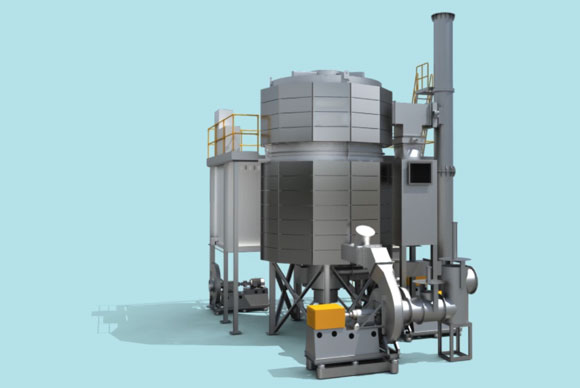What are the operating parameters for RTO with heat recovery?

Regenerative Thermal Oxidizers (RTO) with heat recovery are commonly used to treat VOC emissions from industrial processes. For optimal performance, certain operating parameters must be considered and maintained. In this article, we will discuss the key parameters for operating RTOs with heat recovery.
1. Chamber Temperature
The chamber temperature is the most critical parameter for RTO operation as it directly impacts the destruction efficiency of VOCs. The temperature should be maintained at a level that promotes the complete oxidation of VOCs. The ideal operating temperature range for an RTO is typically between 760-820¡ãC (1400-1500¡ãF).
2. Residence Time
The residence time is the length of time that the gases spend in the RTO chamber. This parameter is important because it allows for the proper mixing and oxidation of VOCs. The residence time should be long enough to ensure complete oxidation of the VOCs. Typically, residence times of 0.5 to 1.5 seconds are recommended for RTOs with heat recovery.
3. Airflow Rate
The airflow rate is the volume of gas flow through the RTO chamber. The airflow rate must be sufficient to ensure that the VOCs are fully oxidized. This parameter is typically measured in cubic feet per minute (CFM). The airflow rate should be adjusted to meet the specific process requirements.
4. Heat Exchanger Efficiency
The heat exchanger is responsible for recovering the heat generated during the oxidation process. The efficiency of the heat exchanger affects the overall energy consumption of the RTO. A higher heat exchanger efficiency will result in less energy consumption and lower operating costs.
5. Control System
The control system is responsible for maintaining the operating parameters within the required range. The control system should be equipped with alarms and safety interlocks to prevent hazardous conditions. The control system should be regularly checked and calibrated to maintain proper operation.
6. Maintenance
Routine maintenance of the RTO is critical for optimal performance and longevity. Maintenance tasks include regular cleaning of the heat exchanger, chamber inspection, and replacement of damaged or worn components. A regular maintenance schedule should be established and followed to ensure proper operation.
7. Process Changes
Any changes to the process being treated by the RTO can impact the operating parameters. It is essential to monitor the process and adjust the RTO parameters as needed to ensure proper operation and compliance.
8. Monitoring and Data Logging
Monitoring and data logging are critical for maintaining the RTO’s operating parameters and ensuring compliance with regulatory requirements. The system should be outfitted with sensors and instruments to monitor the temperature, airflow rate, and other critical parameters. A data logging system should be used to record the system’s performance and identify any deviations from normal operation.
We are a high-tech enterprise that specializes in providing comprehensive treatment for volatile organic compounds (VOCs) waste gas and carbon reduction and energy-saving technology for high-end equipment manufacturing. Our core technical team consists of more than 60 R&D technicians, including 3 senior engineers at the researcher level and 16 senior engineers, who come from the Aerospace Liquid Rocket Engine Research Institute (Aerospace Sixth Institute). Our team possesses four core technologies, including thermal energy, combustion, sealing, and automatic control. We also have the ability to simulate temperature fields and air flow field simulation modeling and calculation. Furthermore, our team has the ability to test the performance of ceramic thermal storage materials, the selection of molecular sieve adsorption materials, and the experimental testing of the high-temperature incineration and oxidation characteristics of VOCs organic matter.
To support our research and development, we have established several key platforms, including a high-efficiency combustion control technology test platform, a molecular sieve adsorption efficiency test platform, an efficient ceramic thermal storage technology test platform, a super high-temperature waste heat recovery test platform, and a gas fluid sealing technology test platform. Each of these platforms has been meticulously designed to ensure the highest level of accuracy and effectiveness in our research and development efforts.
Our production facility is equipped with state-of-the-art technology that includes an automated steel plate and shaped section shot blasting and painting production line, a manual shot blasting production line, dust removal and environmental protection equipment, an automated paint spraying room, and a drying room. Our production capacity is top-notch and allows us to produce high-quality products at an efficient rate.
We are proud to have received numerous patents and awards for our core technologies. We have submitted a total of 68 patent applications, including 21 invention patents, and have been granted four invention patents, forty-one utility model patents, six design patents, and seven software copyrights. These patents cover key components of our technology, ensuring that we provide our customers with the best products on the market.
We invite you to collaborate with us and take advantage of our six key strengths, including our cutting-edge technology, exceptional R&D capabilities, extensive industry expertise, commitment to quality, efficient production capacity, and outstanding customer service. We look forward to working with you to help your business succeed.
Autor: Miya
